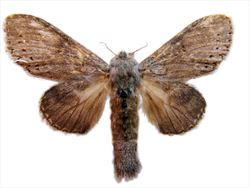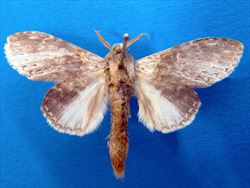OF BIOSECURITY CONCERN
Noctuoidea
Notodontidae 3,800 approximate described species
Worldwide and diverse in Neotropical regions – absent from New Zealand and the Pacific islands
Acacia spp., Mango, Coffee, Tea
Head rough scaled; tympanal organs present in metathorax; forewing base of M2 vein is equal between base of M1 and M3 vein, crenulated termen, Sc runs independently to costa, R1 usually separate from other branches of R, R2, R3, R4 and R5 stalked, M1 can arise from stalk of R4+5 or separate from upper angle of discal cell, M2 arises midway between M1 and M3 or slightly closer to M1 but rarely closer to M3, CuP absent, 1A+2A can be forked basally; hindwing Sc+R1 is close to Rs to end of discal cell, M2 usually starts midway between M1 and M3 or can be weak or vestigial, CuP absent, 1A+2A and 3A present, little or no pattern on hindwings (Common 1990, Kristensen 1999).
Atlas of Living Australia. National Research Infrastructure for Australia, NCRIS. http://www.ala.org.au/
ABRS 2009. Australian Faunal Directory. Australian Biological Resources Study, Canberra. http://www.environment.gov.au/biodiversity/abrs/online-resources/fauna/afd/index.html
Butterflies and moths of North America, collecting and sharing data about Lepidoptera. National Biological Information Infrastructure (NBII) Program and the USGS Northern Prairie Wildlife Research Center. http://butterfliesofamerica.com/links.htm
CSIRO Australian National Insect Collection Database. http://anic.ento.csiro.au/database/
CSIRO Ecosystem Sciences. Australian Moths Online. http://www1.ala.org.au/gallery2/main.php
Herbison-Evans D, Crossley S. Families of Moths in Australia. http://lepidoptera.butterflyhouse.com.au/moths.html
Holloway JD, Kibby G, Djunijanti P (2001) The families of Malesian moths and butterflies, Fauna Malesiana handbook 3, The Netherlands.
iBol Terrestrial Biosurveillance, Lepidoptera barcode of life. http://www.lepbarcoding.org/
Natural History Museum, The Global Lepidoptera Names Index. http://www.nhm.ac.uk/research-curation/research/projects/lepindex/search/index.dsml
Plant Health Australia (2012) Combined High Priority Pest List from Industry Biosecurity Plans. In National Plant Biosecurity Status Report, last accessed June 2015. http://www.planthealthaustralia.com.au/biosecurity/emergency-plant-pests/pest-categorisation/categorised-pests/
Robinson GS, Ackery PR, Kitching IJ, Beccaloni GW, Hernández LM (2001) Hostplants of the moth and butterfly caterpillars of the Oriental Region, The Natural History Museum, London.
The Barcode of Life Data Systems http://www.boldsystems.org/
Common IFB (1990) In Moths of Australia, Melbourne University Press, Carlton, Victoria.
Kristensen NP (ed) (1999) Lepidoptera, Moths and Butterflies: Evolution, Systematics and Biogeography (vol. 1). Handbook of Zoology, Walter de Gruyter, Berlin.
Miller JS (1991) Cladistics and classification of the Notodontidae (Lepidoptera:Noctuoidea) based on larval and adult morphology. Bulletin of the American Museum of Natural History 204:1-266
Northern Australia Quarantine Strategy (2015) Entomology Internal Target List. Australian Government Department of Agriculture.
Operational Science Program (2015) Entomology Internal Target List. Australian Government Department of Agriculture.
Plant Health Australia (2012) Combined High Priority Pest List from Industry Biosecurity Plans. In National Plant Biosecurity Status Report, last accessed June 2015. http://www.planthealthaustralia.com.au/biosecurity/emergency-plant-pests/pest-categorisation/categorised-pests/
van Nieukerken EJ, Kaila L, Kitching IJ, Kristensen NP, Lees DC, et al. (2011) Order Lepidoptera Linnaeus, 1758. In Zhang, Z.-Q. (Ed.) Animal Biodiversity: An outline of higher level classification and survey of taxonomic richness. Order Lepidoptera Linnaeus, 1758. Zootaxa. 3148: 212–221.

